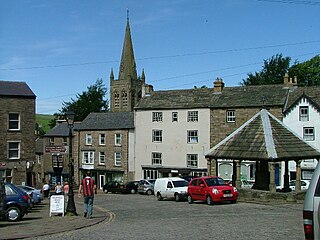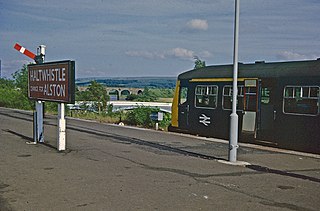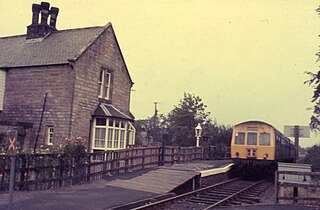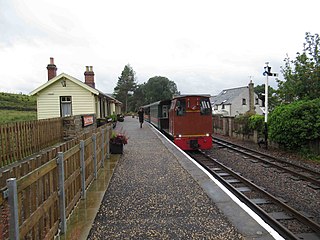
The South Tynedale Railway is a preserved, 2 ft narrow gauge heritage railway in Northern England and is England's highest narrow gauge railway. The line runs from Alston in Cumbria, up the South Tyne Valley, via Gilderdale, Kirkhaugh and Lintley, across the South Tyne, Gilderdale and Whitley Viaducts to Slaggyford in Northumberland.

Alston is a town in Cumbria, England, within the civil parish of Alston Moor on the River South Tyne. It shares the title of the 'highest market town in England', at about 1,000 feet (300 m) above sea level, with Buxton, Derbyshire. Despite its altitude, the town is easily accessible via the many roads which link the town to Weardale, Teesdale, and towns in Cumbria such as Penrith via Hartside Cross, as well as Tynedale. Historically part of Cumberland, Alston lies within the North Pennines, a designated Area of Outstanding Natural Beauty. Much of the town centre is a designated Conservation Area which includes several listed buildings.

The Gloucestershire Warwickshire Steam Railway is a volunteer-run heritage railway which runs along the Gloucestershire/Worcestershire border of the Cotswolds, England.

Haltwhistle is a market town and civil parish in Northumberland, England, 10 miles (16 km) east of Brampton. It had a population of 3,811 at the 2011 Census.

Haltwhistle is a railway station on the Tyne Valley Line, which runs between Newcastle, Hexham and Carlisle. The station serves the town of Haltwhistle in Northumberland. It is owned by Network Rail and managed by Northern Trains.

Thomas Green & Son, Ltd. were engineers who manufactured a wide range of products at the Smithfield Foundry, Leeds, United Kingdom

The Alston Line was a 13-mile (21 km) single-track branch line, which linked Haltwhistle in Northumberland with Alston in Cumbria.

Alston was a railway station on the Alston Line, which ran between Haltwhistle and Alston. The station served the town of Alston in Cumbria.

Kirkhaugh is a very small village adjacent to the River South Tyne in Northumberland, England. The village lies close to the A689 road north of Alston, Cumbria.

Lambley, formerly known as Harper Town, is a village in Northumberland, England about four miles (6 km) southwest of Haltwhistle.The village lies adjacent to the River South Tyne. The place name Lambley refers to the "pasture of lambs". Lambley used to be the site of a small convent of Benedictine Nuns, founded by Adam de Tindale and Heloise, his wife, in the 12th century. The Scots led by William Wallace devastated it in 1296 [Rowland gives 1297]. However it was restored and one William Tynedale was ordained priest to the nunnery in about 1508 – most likely not William Tyndale, the reformer, as once believed but another man of the same name. At the time of the suppression of religious houses by Henry VIII, the nunnery contained six inmates. Nothing now remains but the bell from the nunnery, which hangs in the church, and a few carved stones. The village lies in the Midgeholme Coalfield and there are reserves of good-quality coal remaining.

Slaggyford is a village in Northumberland, England about 5 miles (8 km) north of Alston, Cumbria.

The Tyne Valley Line is a 58-mile (93 km) route, linking Newcastle upon Tyne with Hexham and Carlisle. The line follows the course of the River Tyne through Tyne and Wear and Northumberland. Five stations and two viaducts on the route are listed structures.

Stapleton is a village and civil parish in the City of Carlisle district, in the county of Cumbria, in the North West of England. It falls under this jurisdiction of Cumbria County Council.

Featherstone Park was a railway station on the Alston Line, which ran between Haltwhistle and Alston. The station served the villages of Featherstone and Rowfoot in Northumberland.

Lambley was a railway station on the Alston Line, which ran between Haltwhistle and Alston. The station served the village of Lambley in Northumberland.

The Newcastle & Carlisle Railway (N&CR) was an English railway company formed in 1825 that built a line from Newcastle upon Tyne on Britain's east coast, to Carlisle, on the west coast. The railway began operating mineral trains in 1834 between Blaydon and Hexham, and passengers were carried for the first time the following year. The rest of the line opened in stages, completing a through route between Carlisle and Gateshead, south of the River Tyne in 1837. The directors repeatedly changed their intentions for the route at the eastern end of the line, but finally a line was opened from Scotswood to a Newcastle terminal in 1839. That line was extended twice, reaching Newcastle Central station in 1851.
This is a list of railway stations in Northumberland, with estimated usage figures gathered from data collected by the Office of Rail and Road (ORR). As of May 2020, there are 17 stations located within the county of Northumberland, from which around 2.34 million passenger journeys were made during 2018–19.

Coanwood was a railway station on the Alston Line, which ran between Haltwhistle and Alston. The station served the village of Coanwood in Northumberland.

Slaggyford was a railway station on the Alston Line, which ran between Haltwhistle and Alston. The station served the village of Slaggyford in Northumberland.

Lintley Halt is a railway station on the South Tynedale Railway, which runs between Slaggyford and Alston. The station is located about 1 1⁄4 miles (2 km) from the village of Slaggyford in Northumberland.


















